Finding the right platform to host your online store is important for anyone in the ecommerce sector. Having the ability to enhance your SEO will help you to rise above the competition. In this article, we’ll highlight the pros and cons of Shopify SEO.
In this guide, we will cover:
Pros of Shopify for SEO
Cons of Shopify for SEO
Big brands using Shopify
Shopify is one of the most popular ecommerce platforms and is simple to use, but at the end of the day, you need to drive traffic to your store to reap the benefits. There are mixed opinions on Shopify’s SEO. Whilst Shopify is generally regarded as a good ecommerce platform, you should be aware that there are some potential pitfalls when it comes to advanced SEO.
In this article, we look into some of the pros and cons of using Shopify in terms of SEO.
Pros of Shopify for SEO
1. You can generate an XML sitemap
By generating an XML sitemap, search engines are better able to understand the structure of your site. This can help to make the process of crawling and indexing quicker. Shopify will automatically generate an XML sitemap for you so all you need to do is verify your domain and submit your sitemap to Google Search Console.
2. You can easily manage meta titles, descriptions and redirects
Shopify makes SEO easy, making it ideal for beginners. Shopify will prompt you to add in information about the product that can appear on the Search Engine Results Page (SERPs), such as the page title and meta description.
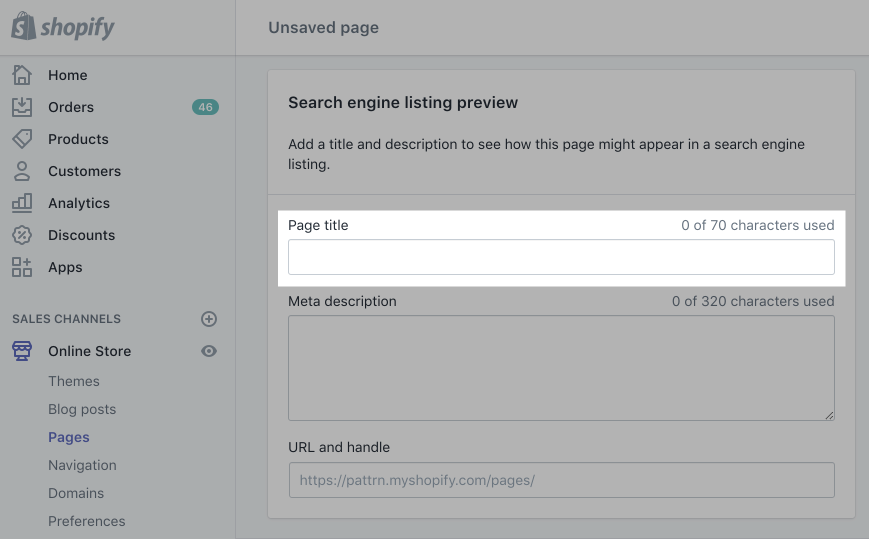
(screenshot from Shopify)
In terms of 301 redirects, Shopify’s redirection feature makes it easy to redirect to new URLs if you have any broken links. This helps to ensure users are able to access all of your webpages which inevitably helps make their experience better!
3. You can auto-generate the robots.txt file
Default robots.txt files are automatically generated on Shopify and this generally works well for online stores. This means that search engines will understand which of your pages to crawl and which ones it should avoid. This is important because all websites have what is called a “crawl budget”. Your crawl budget is the number of URLs which are crawled by a search engine in each session on your site. The number of URLs that are crawled will depend on a combination of factors, grouped around the size, health, and popularity of your website. Therefore, you can make sure your crawl budget isn’t wasted on pages such as checkout, admin pages or search result pages
Essentially, robots.txt files contain rules for crawlers that access your site. An example of a rule you might include is “disallow” which means you can tell bots not to access a certain URL. Below is an example of part of a robots.txt file on a Shopify website. As you can see, all admin, checkout, and search result pages have been added to the file by default.

It’s worth noting that whilst you can give these instructions to crawlers, bots take these as hints and aren’t forced to adhere to them (although most bots will check your robots.txt file first). Shopify also recently introduced an update which allows webmasters to update the robots.txt file, giving them more control over their site’s SEO.
4. It’s mobile friendly
It’s absolutely essential for your site to be mobile friendly if it stands a chance of ranking well. Search engines such as Google have mobile-first indexing which means they use the mobile version of your site’s content for indexing and ranking. The reason for this is because most users will access your site using a mobile device and they want them to have the best experience on pages relating to their query.. Shopify features mobile-friendly themes which have responsive designs, making your site run seamlessly across multiple devices.
5. It enables structured data
Structured data is essentially extra information you can add to your webpages to tell search engines more about the content and relevance. For example, you can add prices, keywords and brands of products (to name a few) which can increase your chance of ranking well. You also have a better chance of having a featured snippet on the SERP which can encourage more users to visit your site (see below an example of a featured snippet which gives users extra information about the product, such as prices and reviews).

6. It has SSL security
When shopping online, users want to make sure that their personal information and credit/debit card details are safe. The security of your site is equally as important to search engines as this indicates your site’s level of trustworthiness which forms part of your Expertise, Authority and Trustworthiness (E-A-T) score. Find out more about E-A-T here.
Shopify has SSL security in place, helping to ensure your site is safe for all users.
7. You can use canonical tags
Shopify sets canonical tags automatically, this helps to prevent duplicate links which have the same content on the page. By having a canonical tag, search engines know to only index one of the pages to prevent duplication issues.
8. There are plenty of SEO plugins available
Shopify offers a vast selection of SEO plugins in its app store, including features enabling you to better optimise images, check keywords and fix broken links. Below are just a handful of apps you can choose to install.
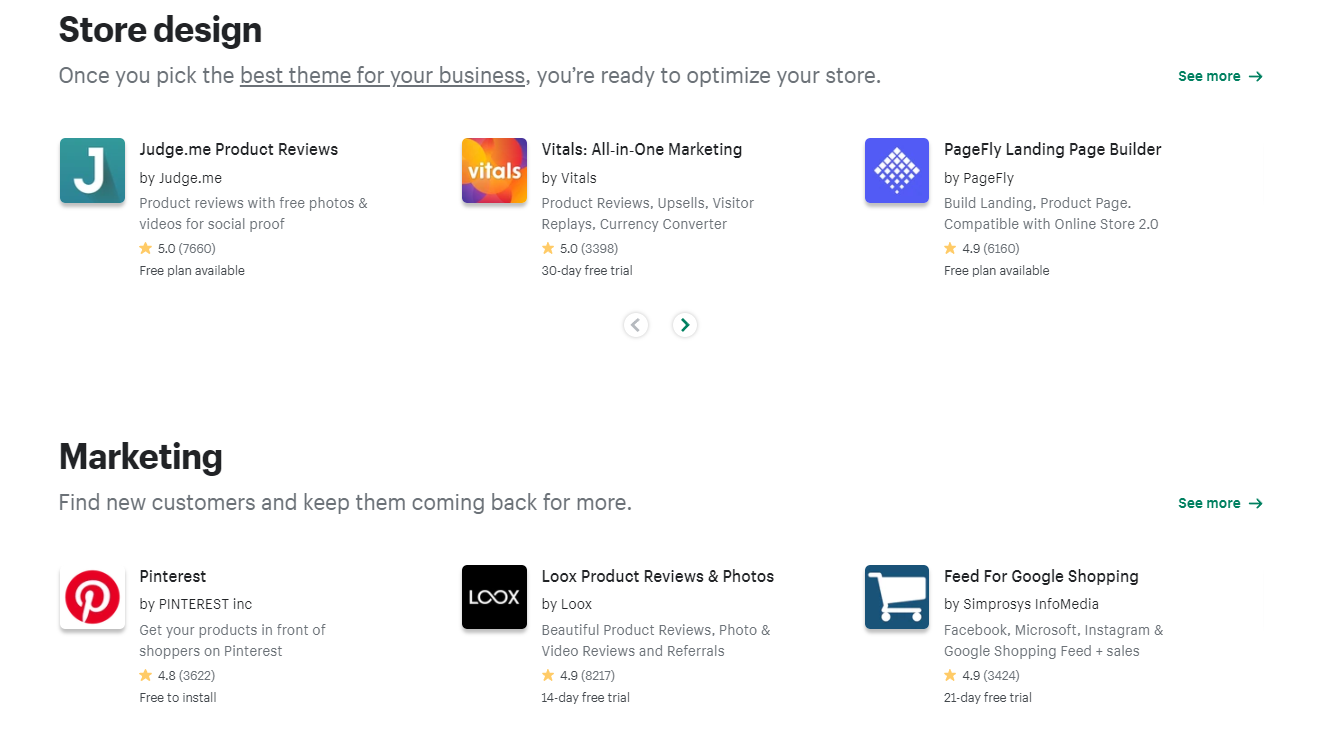
Whilst downloading too many of Shopify’s apps could slow your site down, there are ways to make your ecommerce store faster on Shopify. For example, you could try not to add too many extensions, compress large images and choose a lightweight theme.
9. Shopify generally has good site speed
Website speed is extremely important - not just for search engines ranking your site, but for users who can become easily frustrated (if you keep customers waiting, they’ll probably head to a competitor’s site).
Shopify uses a Content Delivery Network (CDN) which is a network of servers located around the world (and can host a copy of your site). This means that online stores can load quickly on a global scale (despite Shopify’s servers being located in the US). Essentially, it will serve your site from a location which is nearest to the user. Some ecommerce platforms will require you to have your own server, but this is not the case with Shopify.
You can check out Shopify’s handy guide for best practises on improving site speed.
10. You can add Google Analytics (GA)
Shopify enables you to add Google Analytics to your online store so you can easily track and analyse users’ behaviours. With a deep insight into traffic, conversions and more, you’ll be able to improve your marketing strategy with GA data.
11. You can use Shopify for your international SEO strategy
Just two years ago, Shopify started to support international domains and multiple languages, with international features that are optimised for search engines. For example, you can do the following:
- Structure your site with international subdomains which allows you to create webpages for certain countries and regions. This is ideal for international brands such as Gymshark who need their content to be customised for different countries.
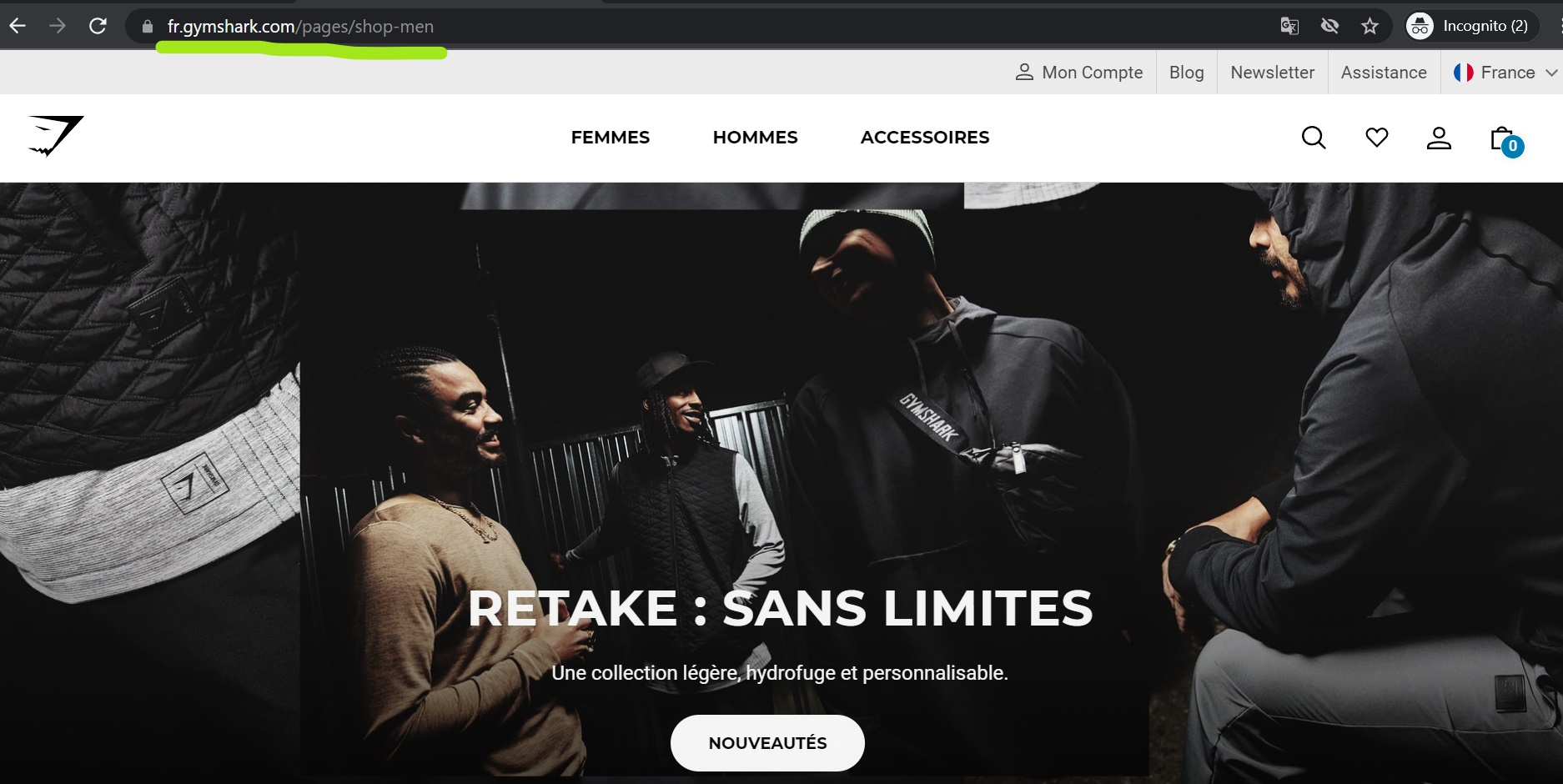
- Structure your site with country code top-level domains (ccTLDS) which tells search engines the countries and regions your webpages are targeting
- Structure you site with country subdirectories (also known as subfolders) which is a type of hierarchy under a root domain
- Add JSON.file data structures which gives search engines more information about your webpages that could earn you a featured snippet on the SERP.
- Add hreflang tags which tells search engines which pages are meant for which countries.
Cons of Shopify for SEO
1. Forced URL structure
One of the things set in stone in Shopify is the URL structure. You will notice that the category URLs always have “/collections/” in the path and product URLs have “/products/”. This is definitely not a great issue in itself, especially if you have always used Shopify as your ecommerce platform. However, if you are migrating from Shopify to another ecommerce platform or vice versa, it will mean that every page on your website will have to be redirected as the URL structure will differ on other platforms.
2. Duplicate Content and Canonical Tags
In Shopify, the product URLs include the collection path in the URL by default. For example, if you have the following product URL on your website, you will be able to access it via different collection pages, depending on which collections the product has been added to:
Product - example.com/products/nike-running-shoes
Collection 1 - example.com/collections/nike-shoes/nike-running-shoes
Collection 2- example.com/collections/running-shoes/nike-running-shoes
Collection 3 - example.com/collections/womens-shoes/nike-running-shoes
These URLs will display the same products and therefore the same content, however they will canonicalise back to the main product page. This means that all internal linking on the collection pages is based on canonicalised URLs. This could be confusing to Google as it’s the canonical tag’s job to tell search engines which is the master copy of a page and yet we won’t be linking to it.
Luckily, this can be fixed but you will need a developer’s help to do so. You can find more information about how to edit the Liquid Theme file in Shopify here, but essentially the fix ensures that any internal links from collection pages actually link to the canonical version - the product URL itself.
3. You can’t edit your sitemap
Shopify generates a sitemap for you. Whilst this sitemap will suit many ecommerce stores, you may feel the need to customise it as your site grows and becomes more complex. As it stands, Shopify does not allow you to make sitemap customisations which is a drawback.
4. The structured data service is perhaps too simple
As mentioned earlier, Shopify allows you to add in structured data which helps search engines understand the context of your webpages and what it is you’re trying to sell. However, the issue is that Shopify’s structured data tool is a little too simplistic for some stores selling products in a range of sizes and colours. That said, there are a couple of ways for you to combat this issue. You could invest in an app (but this will be an extra expense which could impact your site speed), or, you could insert structured data straight into the theme of the site.
5. It’s not the best for blogging
Publishing blogs is a great way for online stores to drive traffic to their site and demonstrate your brand’s expertise (you can even inspire users to make a purchase through your articles!). However, Shopify has a basic blogging interface which may hold you back (for example, it doesn’t have a comments section). That said, users can share articles on social media and easily access related blogs of interest. There is of course also the option for you to invest in blog apps.

6. You may need a hand from web developers
There may be instances where you need the expertise of a web developer to make your site more SEO friendly. For example, they may be needed for fixing canonical tags and adding in additional text fields to category pages.
7. You might fall into the app trap!
As highlighted earlier, Shopify offers plenty of apps that you can install to enhance your site. However, this can slow down your site speed (impacting user experience and rankings) and it could cost you a pretty penny. Some apps will certainly benefit your SEO (such as image optimisation apps), but you should install plug-ins with caution. Try to limit the apps you install and remove any that you don’t get much use out of.
Big brands using Shopify
Despite some drawbacks to the platform that may require the attention of web developers, Shopify is home to some of the biggest brands out there, helping them to grow. Shopify does have a flexible structure and a range of available plugins to improve the site’s functionality, so it’s suitable for both start-ups and enterprise businesses, but here are some well-known brands you may not know use Shopify.
Gymshark
Gymshark is now one of Shopify’s biggest stores and has seen worldwide success. Originally built on Magento, the founder Ben Francis found that it was taking too long to build the site. By the time they were fully up and running, they had outgrown the site and after suffering a catastrophic crash on Black Friday, they migrated to Shopify Plus. Using Shopify Scripts, Gymshark was able to run site-wide promotions, offer reward schemes and automatically hide some shipping options based on the location of customers.

Lazy Oaf
Shopify is great for striking imagery, and Lazy Oaf really plays on their use of bold colours onsite. Spotify provides them with a flexible platform to unleash their creativity as they advertise exciting new collaborations.

KKW Beauty and KKW Fragrance
Even the Kardashians have jumped onto Shopify to sell their brand, with Kim’s beauty and fragrance brands both being hosted on the platform. With over 284 million followers on Instagram alone, attracting visitors to the site wouldn’t have necessarily needed such a big SEO push, however, Shopify Plus helps to meet the product demand and huge spikes in traffic.
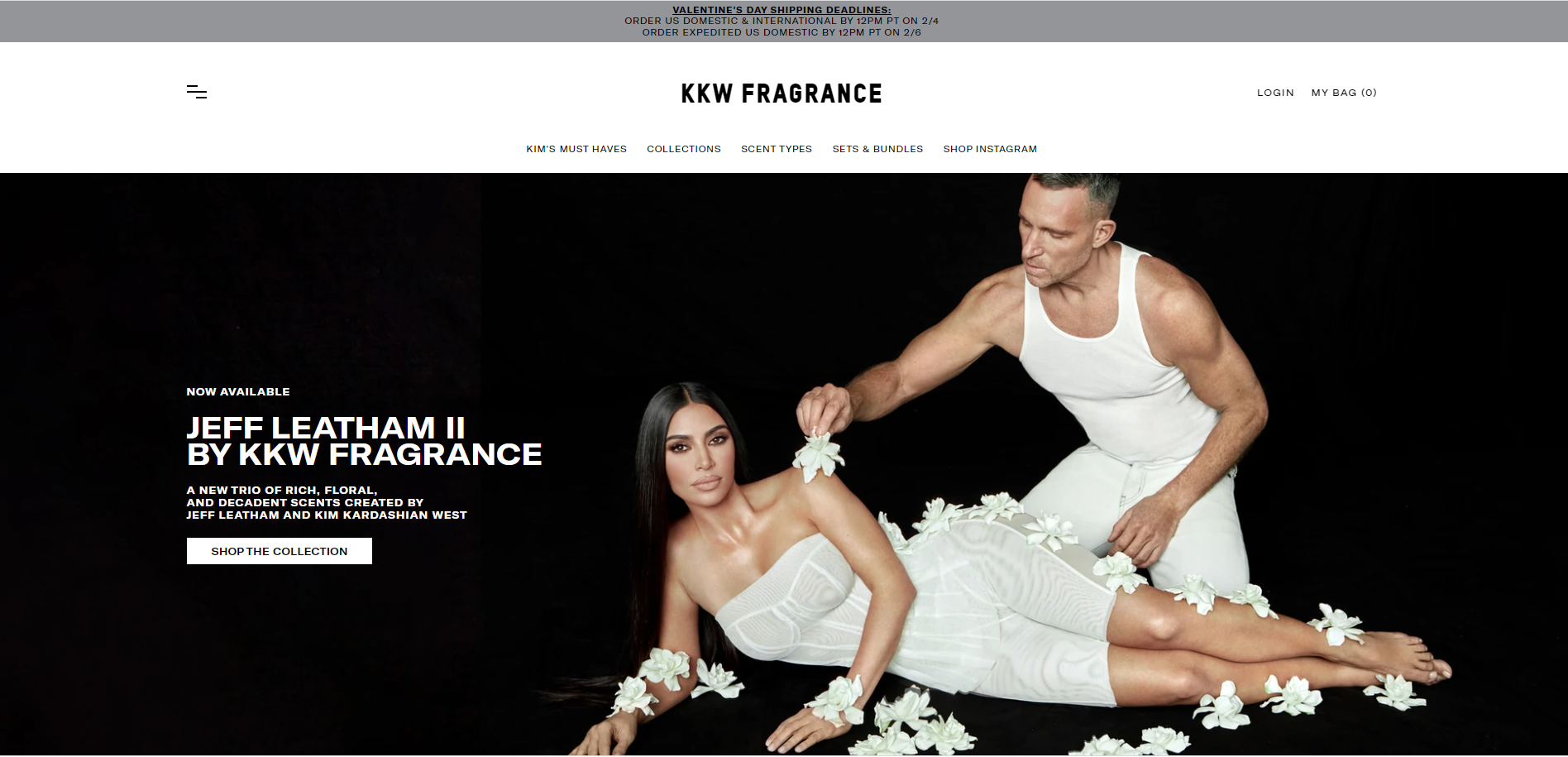
Facetheory
Facetheory is an international sustainable skincare brand using Shopify Plus. They have adopted the subdomain strategy for their International SEO and are growing by the day.

Huel
Another exciting British Brand using Shopify Plus Admin is Huel. Huel (Human Food) is nutritionally complete food that is made from plant-based sustainable ingredients. Huel is a fast growing business that needs a platform to accommodate the changes they face on a daily basis. They are also using the platform for their International websites and have adopted a subdomain structure.
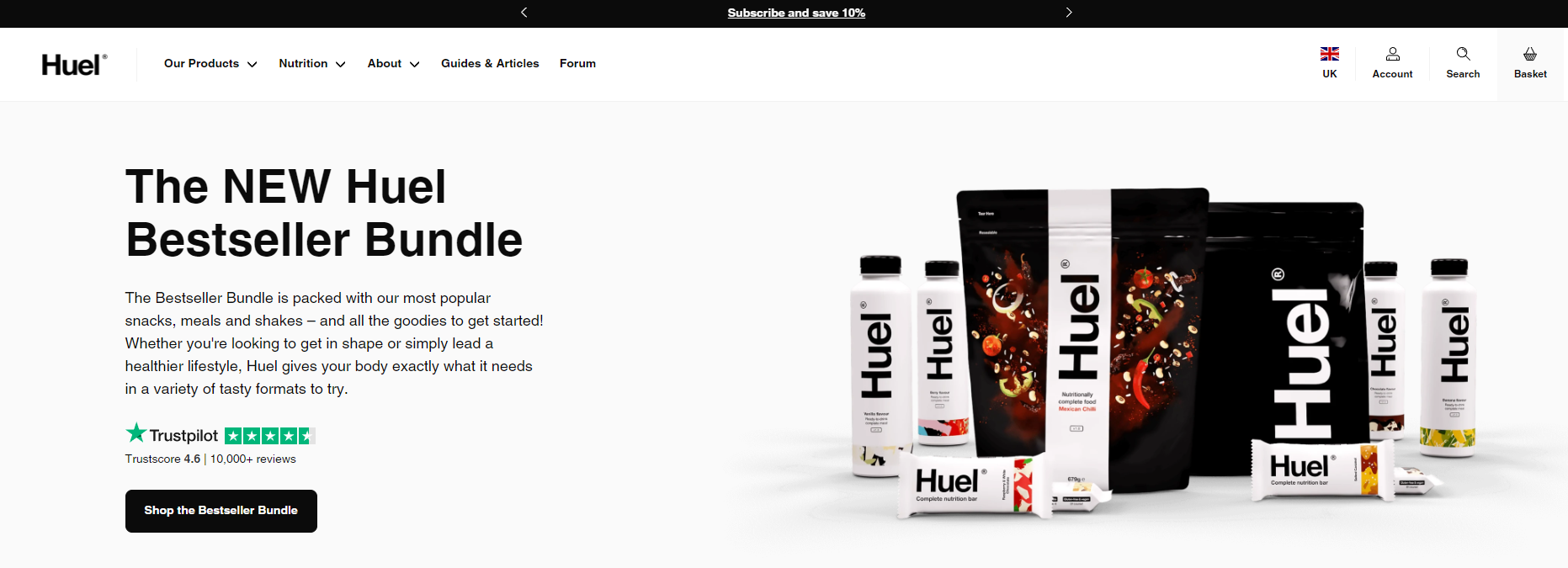
When it comes to big brands, Shopify Plus is regarded as the best enterprise-level solution. This is because it offers brands an unlimited number of staff accounts, has a dedicated support system in place, has even more design flexibility and can handle over 10,000 transactions each minute. Shopify is also the first ecommerce platform to adopt cryptocurrency and to allow crypto payments.
Which ecommerce platform is best for SEO?
Shopify isn’t the only platform that you should be considering so you should explore your options. Whilst Shopify is great for basic SEO, there are other big contenders such as Magento and WooCommerce which may be a better fit - as long as you have experienced developers on hand to help out.
In our blog, ‘How to choose the best ecommerce platform’ we discuss the benefits and drawbacks of the different ecommerce platforms and how SEO friendly they are. Why not take a look to compare ecommerce platforms big and small to determine which will be the best option for your business?
Final thoughts
So there you have it. Shopify is one of the biggest ecommerce platforms out there and is home to well-known brands. Whether you’re a start-up or a large established business looking to migrate, Shopify can make your life easy in terms of SEO. That said, there are some cases where you may want to incorporate more advanced SEO, which will require the help of web developers or the installation of apps (which are more costs to factor in). If you are looking for an Shopify SEO agency to help your site get discovered online, get in touch with our team today.




